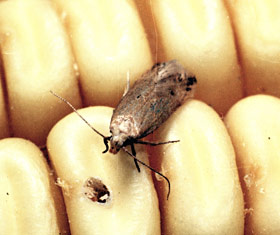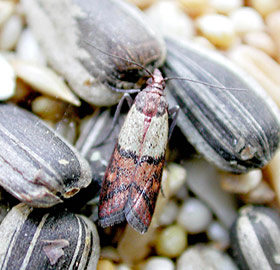Grain Moth, Sitotroga cerealella; Indian Meal Moth, Plodia interpunctella

Angoumois grain moth. Photo: Clemson University - USDA Cooperative Extension Slide Series, Bugwood.org.
IPM Steps to Reduce Grain Moths and Indian Meal Moths
1. Sample for Pest
Confirm the presence of these pests.
Where to find it while inspecting: Both of these grain moths are found inside any stored food area: large storage of grain or a small box on a shelf.
2. Proper ID
Before you act, determine what species of pantry pest is in your building.
Size and Particulars: Indian Meal Moth adults are 3/8–1/2" long with brown-shaded wings that are 3/4" wide when open and show coppery tips. Larvae are dull white and mature at 1/2" long; Grain Moth adults are small yellowish-brown moths about 1/3" long, front wings are lighter than rear and both have fringed rear margins. Larvae mature at 1/5" and are long and white with a yellow head.
3. Learn the Pest Biology

Indian meal moth. Photo: Pest and Diseases Image Library, Bugwood.org.
Knowing the life cycle and habitat needs helps you fight these pests.
Life Cycle: Indian meal moth—females lay 100–400 eggs on the food supply. Larvae establish in crevices in the food and cover with a webbing where it eats for 13–288 days depending on temperature and food supply. Larvae leave to find pupation sites. Angoumois grain moth—females lay 40–380 eggs near grain. Eggs turn red with age and hatch in 4–8 days. The larva (first instar) bores into grain and grows there over 3 weeks before pupation (2 more weeks) before adults emerge.
Preferred Food Sources: Grain moth—stored whole grains such as corn kernels, plus oats, barley, rice, and seeds. Indian meal moth—general feeders of stored dry foods such as all grains and grain products, dried fruits, seeds, nuts crackers, powdered milk and cookies.
Preferred Habitat: Grain moths prefer whole grains to lay eggs but larvae can be unintentionally transferred into other products. Adults are attracted to lights and the female will lay eggs on both outdoor pre-harvest grains and indoor stored grain. Meal moths prefer to lay eggs near food but the adults may be seen flying around in other areas.
4. Determine Threshold
What are the thresholds for pantry moths?
Threshold: Any confirmed sighting of pantry moths calls for a close inspection and renewed sanitation. Finding any hint of infestation must be dealt with as the larvae can be very damaging to stored food and are likely present.
5. Choose Tactics
IPM for indoor pests is always a combination of exclusion and sanitation: Try to keep them out. Don’t provide water, food and shelter if they enter your building.
Best Management Practices: The number one way to reduce pantry pests is paired exclusion and sanitation. Inspect any incoming food for pests. Block infestations by keeping all foods in clean, airtight containers. Reduce or use no cardboard or paper packaging, and keep shelf space clean and free of any food debris. Monitor stored foods on a regular basis by visual inspections and use of sticky pads. Pheromone baits/traps can be effective in both monitoring and slowing infestation by trapping adults. Store foods properly in tight pest-proof containers, rotate stock.
Treatment Methods: Note: Indian meal moths pupate away from stored food, while grain beetles pupate inside kernels and grains. Capture adults with vacuums. Remove all product from storage and locate the source of the infestation. Stored product pests can be killed by freezing, heating, dehydrating. Baits: Pheromone traps are often used to trap moths. Check your local guidelines for use.
6. Evaluate
Was the tactic successful? Record the date pests were first noted, and the tactic you used, and its success. Use one of our RECORD KEEPING tools.
For More Information:
Cornell University Insect Diagnostic Lab: Indian Meal Moths
Penn State Dept. of Entomology: Angoumois Grain Moth
Remember:
When a pesticide application is necessary, all necessary and required precautions are taken to minimize risk to people and the environment and to minimize risk of pesticide resistance or pest resurgence. Pesticide use in your school may be prohibited or regulated by local policies or state and federal regulations. Risk reduction methods can include, but are not limited to, spot-treatment, the use of gel or paste bait formulations placed in inaccessible locations, injection into a crack or crevice, and other methods that reduce potential exposure.